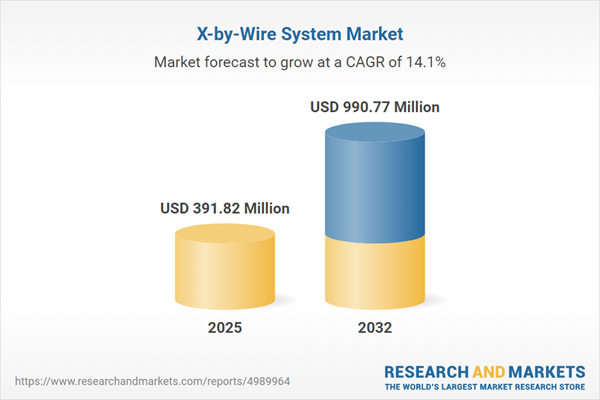Speak directly to the analyst to clarify any post sales queries you may have.
The X-by-Wire system market is redefining automotive operational models, presenting senior decision-makers with actionable solutions for enhanced automation, efficiency, and risk management. As digital transformation reshapes the sector, X-by-Wire platforms are enabling organizations to align with rapidly evolving technology and industry standards.
X-by-Wire System Market Snapshot
The X-by-Wire system market is undergoing sustained expansion as manufacturers transition from traditional mechanical controls to advanced electronic platforms. Between 2024 and 2032, the market is forecast to reach a notable compound annual growth rate (CAGR), driven by significant capital inflows and the modernization of automotive architectures. Market momentum is fueled by escalating adoption of vehicle electrification initiatives, the fast-paced integration of digital platforms, and strict adherence to new connectivity and manufacturing protocols. Both electric and internal combustion vehicles are integrating these systems to improve operational integrity, safety, and adaptability. Technology projects increasingly emphasize open system designs, integration flexibility, and reinforced supply chain and compliance frameworks in global automotive ecosystems.
X-by-Wire System Market Scope & Segmentation
Comprehensive segmentation of the X-by-Wire system market supports focused investment and operational decisions. Segment analysis aids those overseeing strategic growth to identify innovation opportunities, align with regulatory environments, and mitigate risk in technology adoption and deployment.
- Component: Critical elements such as actuators, electronic control units, sensors, and wiring harnesses enable the configuration of reliable, scalable X-by-Wire solutions tailored to diverse vehicle needs.
- Propulsion Type: Diesel, gasoline, battery electric, hybrid, and fuel cell systems facilitate adaptable fleet strategies and improved flexibility, meeting regional regulations and market preferences.
- System Type: Brake-by-wire, shift-by-wire, steer-by-wire, and throttle-by-wire systems equip OEMs and suppliers to advance vehicle automation, improve efficiency, and raise operational safety standards.
- Technology: The adoption of fully electric and hybrid models enables market participants to address evolving sustainability requirements and maintain regulatory compliance in dynamic global settings.
- Sales Channel: Original equipment manufacturer (OEM) sourcing and aftermarket services provide varied procurement models and life cycle management solutions, streamlining operations for professional fleets.
- Vehicle Type: Applications span passenger, light commercial, and heavy commercial vehicles, supporting demand across logistics, transit, and growth in autonomous vehicle deployment.
- Regional Coverage: The Americas, Europe, Middle East and Africa, and Asia-Pacific encompass extensive regional analysis, with market insights specified for the U.S., Canada, Germany, Japan, and China to inform strategy at the local level.
- Major Companies: Leading industry participants, including Robert Bosch GmbH, Continental AG, ZF Friedrichshafen AG, DENSO Corporation, Hitachi Automotive Systems Ltd., Aptiv plc, Magna International Inc., Mitsubishi Electric Corporation, NSK Ltd., and Nexteer Automotive Corporation, offer benchmarking and partnership potential within the industry value chain.
This segmentation framework supports informed technology investments by ensuring organizational alignment with evolving market demands and compliance imperatives across categories and geographies.
X-by-Wire System Market: Key Takeaways for Senior Decision-Makers
- Configurable X-by-Wire architectures let organizations swiftly adjust to market and regulatory shifts, accelerating new product launches and maintaining agility.
- Integration of lightweight and energy-efficient system components aids seamless pairing with advanced driver assistance and telematics solutions, advancing sustainability and emissions goals.
- Strengthened cybersecurity features are essential to safeguard electronic networks and sustain operational reliability, particularly in digitally connected fleet operations.
- Utilization of advanced simulation and virtual validation methods expedites product approval cycles while helping manage technical complexity and reduce potential implementation risks.
- Prioritizing robust supply chain management and compliance protocols offsets business disruptions related to international sourcing challenges and regulatory variability.
- Unified hardware and software solutions enable predictive maintenance, supporting real-time diagnostics and enhanced asset uptime for fleet operators.
Pursuing these strategic directions enables businesses to optimize technology returns and maintain long-term operational flexibility within shifting market environments.
X-by-Wire System Market: Tariff Impact and Supply Chain Dynamics
Anticipated U.S. tariffs scheduled for 2025 are prompting automotive manufacturers and suppliers to reassess sourcing and production strategies in the X-by-Wire system market. In response to these regulatory shifts, organizations are prioritizing domestic manufacturing, enhancing supplier networks, and adapting system designs to reduce exposure to global supply disruptions. This approach maintains resilience and continuity across geographic markets.
Methodology & Data Sources
Insights presented in this report are the result of structured interviews with automotive industry executives and regulators, analyzed alongside comprehensive shipment data and trade flow reviews. This approach delivers an evidence-based foundation for senior leaders evaluating X-by-Wire system investments.
Why This Report Matters
- Provides clear, actionable guidance for investment planning, technology evaluation, and operational leadership in X-by-Wire system adoption.
- Prepares organizations to respond confidently to regulatory developments and supply chain realignments on both global and local scales.
- Offers focused recommendations for aligning innovation initiatives with sustainability and market expectations for continued sector growth.
Conclusion
X-by-Wire system solutions are central to advancing automotive performance, agility, and digital integration. Adopting these technologies supports operational value as the industry progresses toward more connected and automated vehicle platforms.
Additional Product Information:
- Purchase of this report includes 1 year online access with quarterly updates.
- This report can be updated on request. Please contact our Customer Experience team using the Ask a Question widget on our website.
Table of Contents
3. Executive Summary
4. Market Overview
7. Cumulative Impact of Artificial Intelligence 2025
Companies Mentioned
The companies profiled in this X-by-Wire System market report include:- Robert Bosch GmbH
- Continental AG
- ZF Friedrichshafen AG
- DENSO Corporation
- Hitachi Automotive Systems, Ltd.
- Aptiv plc
- Magna International Inc.
- Mitsubishi Electric Corporation
- NSK Ltd.
- Nexteer Automotive Corporation
Table Information
| Report Attribute | Details |
|---|---|
| No. of Pages | 185 |
| Published | October 2025 |
| Forecast Period | 2025 - 2032 |
| Estimated Market Value ( USD | $ 391.82 Million |
| Forecasted Market Value ( USD | $ 990.77 Million |
| Compound Annual Growth Rate | 14.1% |
| Regions Covered | Global |
| No. of Companies Mentioned | 11 |









